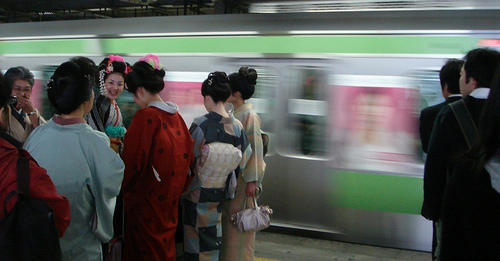Lesson 5 - Vocabulary:
Subways and trains
(photo
by Christophe Richard used
under terms of Creative Commons license.)

The system of writing Japanese used in this course is called the Hepburn system. Pronunciation of most of the letters presents no difficulty to an American. Those letters or combinations of letters considered difficult to pronounce will be explained in this section of the lessons.
|
ichi-ban |
sumimasen |
2 . The letters with a bar above them, ā, ē, ī, ō and ū are pronounced longer than those without a bar. Listen:
|
sā |
ē |
nē
|
ī |
īe |
sō
|
dōmo
|
jū |
kyūkō |
3. When i and u are written with a slash mark through them, they are slurred, or barely pronounced. Listen:
|
des |
Asak |
Ak |
Shimo-K |
4. When
double letters appear
in a Japanese
word, as in Fussa,
the sound
is repeated. Think
of double letters
as having a hyphen
between them, and
pronounce both letters distinctly. Listen:
Fus-sa
5. The
letter g in
the middle of
a word is
pronounced like the ng
in "sing" by
natives of
|
tsugi
|
chigaimas |
Sagami-Ōno |
|
sumimasen |
excuse
me |
|
des |
is;
am; are
|
|
des |
is
it? |
|
des |
isn't
it? |
|
tsugi |
next |
|
tsugi Sagami-Ōno
des |
Sagami-Ono
is next, isn't
it? |
|
kore |
this
one |
|
sore |
that
one |
|
are |
that
one over there |
|
dore? |
which
one? |
|
Shinjuk |
which
one is for
Shinjuku? |
|
dore demo
ī
des |
anyone
will do |
|
kyūkō |
express |
|
kore kyūkō des |
is
this the express? |
|
kochira |
this
way |
|
sochira |
that
way |
|
achira |
over
that way
|
|
dochira? |
which
way? |
|
dochira des |
which
way is it? |
|
( PIace) iki |
going
to (place)
|
|
Sōbudai-mae iki
dochira des |
which
way to the
train going
to Sobudai-mae? |
|
kore
Sōbudai-mae iki des |
is
this one (the
train) going
to Sobudai-mae? |
|
koko |
here;
this place
|
|
soko |
there;
that place
|
|
asoko |
over
there; that place
over there
|
|
doko? |
where?;
which place?
|
|
Sōbudai-mae
iki koko
des |
is
this the place
(for trains)
to Sobudai-mae? |
|
sā
nē |
gee |
|
wakarimasen |
I
don't know
|
|
wakaranai |
I
don't know
|
|
sā
nē, wakaranai! |
gee,
I don't know |
|
hai |
yes |
|
ē |
yes |
|
sō
des |
it
is; that's right |
|
hai, sō
des |
yes,
it is
|
|
īe |
no;
it's nothing
|
|
iya |
no |
|
iya, chigaimas |
no,
it's not (literally, "no, that's wrong") |
|
kaete kudasai |
please
change |
|
kore kaete
kudasai |
please
change this
|
|
gomen nasai |
pardon
me; I'm sorry |
|
dōmo |
thank
you |
|
ichi-ban |
number
one |
|
ni-ban |
number
two |
|
sam-ban |
number
three |
|
yom-ban |
number
four |
|
go-ban |
number
five |
|
rok |
number
six |
|
nana-ban |
number
seven |
|
hachi-ban |
number
eight |
|
kyū-ban |
number
nine |
|
jū-ban |
number
ten |
|
sen |
track |
|
ichi-ban
sen |
track
number one
|
|
yom-ban sen
des |
it's
track number four |
|
jū |
10 |
|
ni-jū |
20
(literally, "two tens") |
|
san-jū |
30 |
|
yon-jū |
40 |
|
go-jū |
50 |
|
rok |
60 |
|
nana-jū |
70 |
|
hachi-jū |
80 |
|
kyū-jū |
90 |
|
hyak |
100 |
|
ni-hyak |
200 |
|
sam-byak |
300 |
|
yon-hyak |
400 |
|
en |
yen
(Japanese currency unit,
¥) |
|
hachi-jū
en |
¥80 |
|
ikura? |
how
much? |
|
ikura
des |
how
much is it? |
|
(place)
made |
to
(place); as far
as (place)
|
|
Ueno made
ikura des |
how
much is it
to Ueno?
|
|
sam-byak |
it's ¥330 |